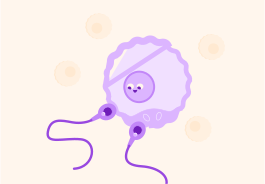YOU ARE LEARNING:
Contraception

Contraception
Contraception can be used by men and women to prevent pregnancy. There are many different hormonal and non-hormonal methods which use different substances to avoid pregnancies.
The menstrual cycle is a continuous monthly cycle. That means that if a woman has intercourse, she could get pregnant at any time. To prevent unplanned pregnancies, fertility is controlled through different methods. Contraception falls into two main categories: Hormonal and non-hormonal methods.
Which two of these hormones do you think is involved in hormonal contraception?

You can select multiple answers
Oestrogen and progesterone are both used in hormonal contraception because they inhibit the production of FSH, which means the egg won't mature. This means that oestrogen and progesterone drastically reduce the chances of a sperm meeting an egg.
Why might you actually think that taking oestrogen would help a woman get pregnant, rather than preventing it?

So, oestrogen helps to prevent pregnancy by preventing FSH from being produced. If FSH is not produced, the egg will not mature. This means that LH will not be able to release a mature egg from a follicle during ovulation.
Progesterone also inhibits FSH. It also inhibits LH which releases a mature egg. However, there is actually a third reason why progesterone helps prevent pregnancy. What do you think it is?

So oestrogen and progesterone can be used to help prevent pregnancy.
One method of taking these hormones is 'the pill'.
The pill must be taken daily, and can be over 99% effective if taken correctly. **** Some women get side effects, such as headaches and nausea.
There is also a pill that contains progesterone only.
It is just as effective and can produce fewer side effects that the combined contraceptive pill.
So women have to remember to take the pill every day and they might experience side effects. What do you think is another disadvantage of this form of contraception?

Similarly to the combined contraceptive pill, a contraceptive patch containing oestrogen and progesterone can be stuck onto the skin. These patches last for about one week.
There are other progesterone only types of contraception.
The contraceptive implant
This implant is inserted in the upper arm, just under the skin. It continuously releases progesterone and lasts for three years.
What does the implant do to a woman's menstrual cycle? Pick the two options you think are correct.

You can select multiple answers
Women can also get a progesterone injection. One contraceptive injection supplies a woman with progesterone for 2-3 months.
There is one other type of hormonal contraception, and that's the intrauterine device (IUD).
The device gets its name from its position in the uterus. Intra- means "inside". The device goes inside the uterus.

There are two T shaped devices, one made from plastic which releases progesterone, and one made from copper. What do you think the plastic one does?
A) Kills sperm surviving in the uterus B) Prevents an egg from implanting in the uterus C) Causes the exit from the ovaries to be blocked
Answer A, B or C.


The copper device also goes inside the uterus.
It causes sperm to be killed in the uterus.

Non-hormonal methods of contraception stop the sperm reaching the egg. These include...
The diaphragm
This is shallow plastic cup that sits over the entrance to the uterus (called the cervix). It prevents sperm from entering. It has to be used alongside a spermicide (a gel-like substance that kills sperm).
Condoms
Males wear them over the penis during sexual intercourse to stop sperm entering the vagina. Females can also use their own form of condoms, which go inside the vagina.
Condoms are the only type of contraception to have a specific benefit. What do you think this is?

The previously mentioned spermicide can be used on its own, but it is less effective. All other forms of contraception discussed so far are between 97-99%+ effective. How effective do you think spermicide is?

One drastic solution is surgery. A process called sterilisation can cut or tie the fallopian tubes in a female or the sperm duct in males. This is considered permanent contraception, **** although there is a very small chance the cut ends of the tubes can rejoin.
Lastly, there are more natural methods which can help prevent pregnancy.
Complete abstinence
This means that people don't have intercourse at all, unless they are trying to get pregnant. This is the only way you can be completely sure a woman won't get pregnant.
Another way is to sync intercourse with times in a woman's menstrual cycle when she is least fertile. This is popular for people who don't want to artificially influence fertility. Do you think this is very effective?

So, we have discussed...
5 hormonal methods of contraception (the pill, patch, implant, injection, IUD) 3 non-hormonal methods (diaphragm, condom, spermicide) 1 surgical method (sterilisation) 2 natural methods (complete abstinence and timing intercourse)
Which of these are progesterone only forms of contraception? Select all the options you think are correct.

You can select multiple answers
Which of these form of contraception have both oestrogen and progesterone (combined)?

You can select multiple answers
What does copper in an intrauterine device do?

